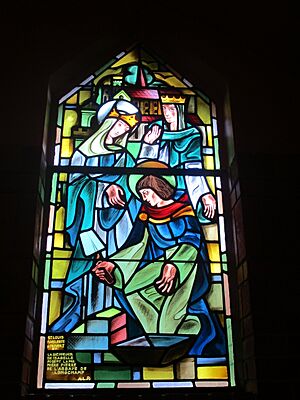Saint Isabelle of France facts for kids
Quick facts for kids Isabelle of France |
|
|---|---|

St. Isabelle at the Church of Saint-Germain l'Auxerrois in Paris, a Neo-Gothic replica of the original statue
|
|
| Born | March 1225 Paris, France |
| Died | 23 February 1270 Longchamp, Pays de France, Kingdom of France |
| Burial | Longchamp Abbey, Pays de France, Kingdom of France |
| House | Capet |
| Father | Louis VIII of France |
| Mother | Blanche of Castile |
| St. Isabelle of France | |
|---|---|
| Venerated in | Catholic Church (Poor Clares in France) |
| Beatified | 1521 by Pope Leo X |
| Canonized | 1696 by Pope Innocent XII |
| Feast | 26 February |
| Patronage | Patroness of the Sick |
Isabelle of France was a French princess born in March 1225. She was the daughter of Louis VIII of France and Blanche of Castile. Isabelle was the younger sister of King Louis IX of France, also known as Saint Louis. She dedicated her life to God and founded the Longchamp nunnery near Paris in 1256. The Franciscan Order honors her as a saint, and her feast day is celebrated on February 26.
Contents
Meet Princess Isabelle of France
Isabelle was a princess who lived a long time ago, from 1225 to 1270. She was part of the royal family of France. Her father was King Louis VIII, and her mother was Queen Blanche of Castile. She had a famous brother, Louis IX, who also became a saint. Isabelle chose a special path in life, dedicating herself to serving God.
Isabelle's Childhood and Choices
Isabelle was born in Paris in March 1225. Her father, King Louis VIII, passed away when she was only two years old. Her mother, Queen Blanche, made sure Isabelle received a good education. Isabelle learned to read both Latin and French. She enjoyed stories about brave knights and also religious books.
Besides traditional activities like embroidery, she loved making special clothes for priests. From a young age, she felt a strong connection to God. She sought guidance from the Franciscans, a religious group, and grew even more devoted.
As she grew older, Isabelle decided she wanted to dedicate her life to God. She chose not to marry, even though she was betrothed to a prince named Hugh when she was young. Later, she also turned down a proposal from Conrad IV, the son of a powerful emperor. She was firm in her decision to live a life of prayer and service.
Founding Longchamp Abbey
Isabelle wanted to create a special place for women who wished to live a life dedicated to God, similar to the Franciscan friars. Her brother, King Louis IX, helped her make this dream come true. In 1255, he started buying land in the Forest of Rouvray, which is now known as the Bois de Boulogne in Paris.
On June 10, 1256, the first stone of the new monastery church was laid. This new community was called the Convent of the Humility of the Blessed Virgin. Isabelle, with the help of Franciscan scholars, created a special set of rules for the nuns. These rules allowed the community to own property. The nuns were known as the Sisters of the Humble Order of Servants of the Most Blessed Virgin Mary.
A Life of Devotion and Legacy
After her mother passed away, Isabelle moved to Longchamp. She lived in a separate room from the nuns. She chose not to become the abbess, which is the leader of the abbey. This allowed her to keep her own resources, which she used to support the abbey and help people in need.
Isabelle lived a very disciplined life, often observing silence for most of her day. Her brother, King Louis IX, frequently visited her at the abbey. She faced various illnesses throughout her life, but her devotion never wavered. Isabelle passed away at Longchamp on February 23, 1270, and was buried in the abbey church.
Becoming a Saint
After Isabelle's death, many people believed she was a saint. Nine days after her burial, her body was found to be well-preserved, which was seen as a sign of her holiness. Many miracles were also said to have happened at her grave.
Over the centuries, the Catholic Church recognized her special holiness. In 1521, Pope Leo X allowed her feast day to be celebrated. Later, in 1696, Pope Innocent XII officially declared her a saint.
Sadly, during the French Revolution, Longchamp Abbey was closed down. The buildings were eventually destroyed, and the land became part of the Bois de Boulogne. Today, Isabelle's relics, which are sacred remains, are kept in the Basilica of Saint-Denis.
See also
 In Spanish: Isabel de Francia (santa) para niños
In Spanish: Isabel de Francia (santa) para niños


